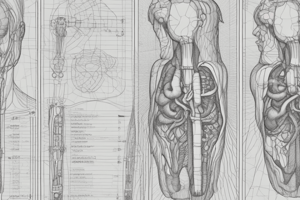Podcast
Questions and Answers
What is the impact of high noise levels on contrast in imaging?
What is the impact of high noise levels on contrast in imaging?
- Increases contrast by enhancing fine details
- Does not affect contrast
- Improves contrast by sharpening structures
- Reduces contrast by obscuring fine details (correct)
How does higher tube current affect image quality in radiology?
How does higher tube current affect image quality in radiology?
- Reduces radiation exposure
- Improves image quality
- Decreases image quality (correct)
- Enhances contrast
What effect do inherent tissue properties have on contrast in imaging?
What effect do inherent tissue properties have on contrast in imaging?
- Balances tube current
- Affects tissue brightness and contrast (correct)
- Increases noise levels
- Minimizes reconstruction algorithms
How does beam kilovoltage influence radiological imaging?
How does beam kilovoltage influence radiological imaging?
Which method can help minimize noise levels in imaging?
Which method can help minimize noise levels in imaging?
What is an essential consideration for achieving optimal contrast in imaging?
What is an essential consideration for achieving optimal contrast in imaging?
What is the primary reason for using lower kilovoltages in X-ray imaging?
What is the primary reason for using lower kilovoltages in X-ray imaging?
Which of the following is a potential disadvantage of reducing kilovoltage in X-ray imaging?
Which of the following is a potential disadvantage of reducing kilovoltage in X-ray imaging?
What is the primary function of contrast media in MRI?
What is the primary function of contrast media in MRI?
In CT scans, what is the purpose of intravenous administration of contrast media?
In CT scans, what is the purpose of intravenous administration of contrast media?
Which of the following factors can influence the effectiveness of contrast media in enhancing image contrast?
Which of the following factors can influence the effectiveness of contrast media in enhancing image contrast?
What is crucial for optimizing image contrast in various imaging modalities?
What is crucial for optimizing image contrast in various imaging modalities?
Study Notes
Factors Influencing Contrast
When it comes to understanding how contrast works, several factors come into play. These factors can significantly impact the perception of images and their diagnostic potential, especially in medical imaging techniques like computed tomography (CT) and magnetic resonance imaging (MRI). Here's a breakdown of the key factors that contribute to contrast and their effects:
Noise
Noise refers to the random variation in signal intensity that can occur when acquiring images. High noise levels can reduce contrast by obscuring fine details and making it difficult to differentiate between structures. Strategies to minimize noise include increasing the scan time, using faster imaging protocols, and optimizing the reconstruction algorithms.
Tube Current
The tube current is a critical parameter in radiology because it affects the number of X-rays emitted by the source. Higher currents result in increased radiation exposure to patients, while lower currents reduce image quality. Balancing tube current and patient dose is essential for achieving optimal contrast.
Inherent Tissue Properties
Tissues contain varying amounts of fat, protein, water, and other components, which affect the absorption of imaging agents such as gadolinium molecules in MRIs or iodine compounds in CT scans. These inherent properties can cause variations in tissue brightness and contrast.
Beam Kilovoltage
Kilovoltage is another important factor in radiological imaging. Lower kilovoltages generally produce softer radiation beams, which can help improve contrast in certain situations. However, reducing kilovoltage may also increase noise levels and limit the penetrating power of X-ray beams, requiring higher energy levels to obtain adequate image quality.
Use of Contrast Media
In MRI, contrast agents like gadolinium chelates facilitate the identification of diseased tissues by enhancing signals from specific areas. Similarly, in CT scans, intravenous administration of contrast media helps distinguish different tissues based on their attenuation coefficients. Factors such as concentration, timing, and mode of administration can influence the effectiveness of contrast media in enhancing image contrast.
In summary, understanding these factors and their interactions is crucial for optimizing image contrast in various imaging modalities. By carefully considering and adjusting these parameters, radiologists and medical professionals can improve the diagnostic potential of imaging techniques and ultimately enhance patient care.
Studying That Suits You
Use AI to generate personalized quizzes and flashcards to suit your learning preferences.
Description
Explore the key factors that influence image contrast in medical imaging techniques such as computed tomography (CT) and magnetic resonance imaging (MRI). Learn how noise, tube current, inherent tissue properties, beam kilovoltage, and contrast media affect contrast levels and diagnostic potential in radiological imaging.




